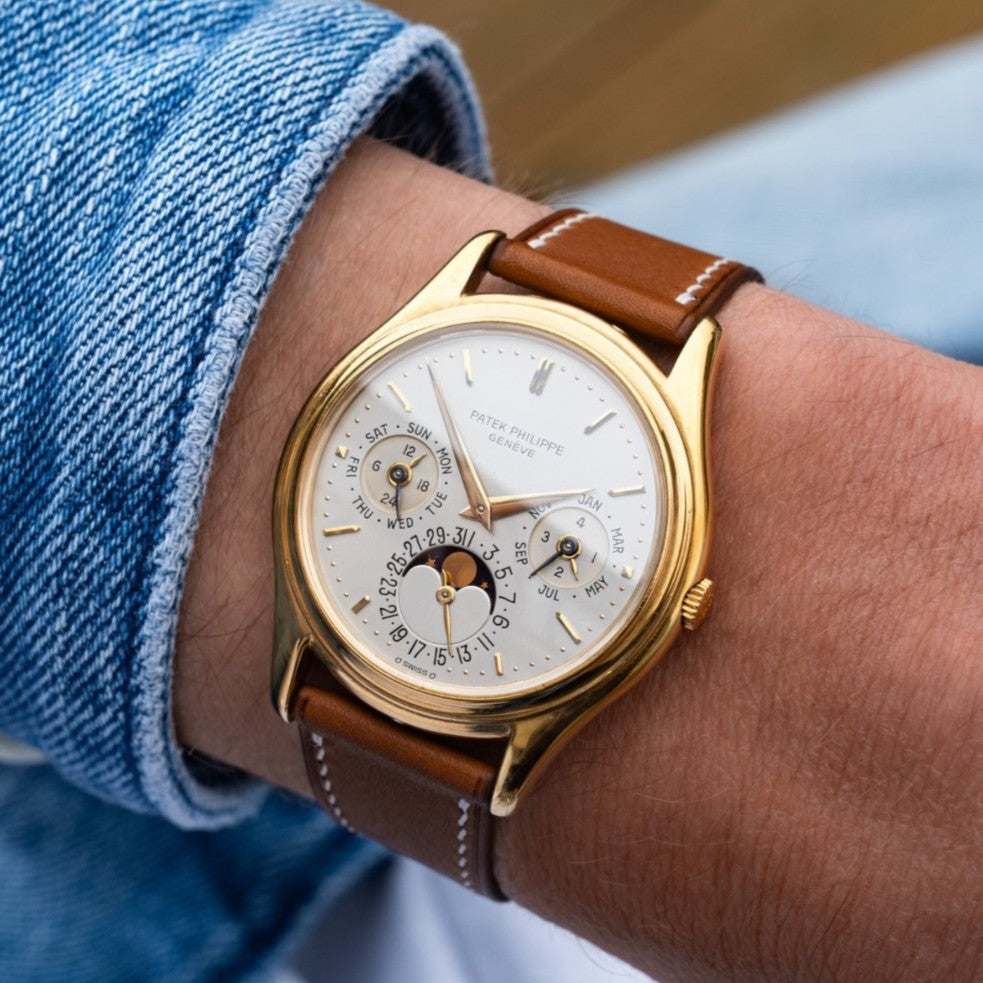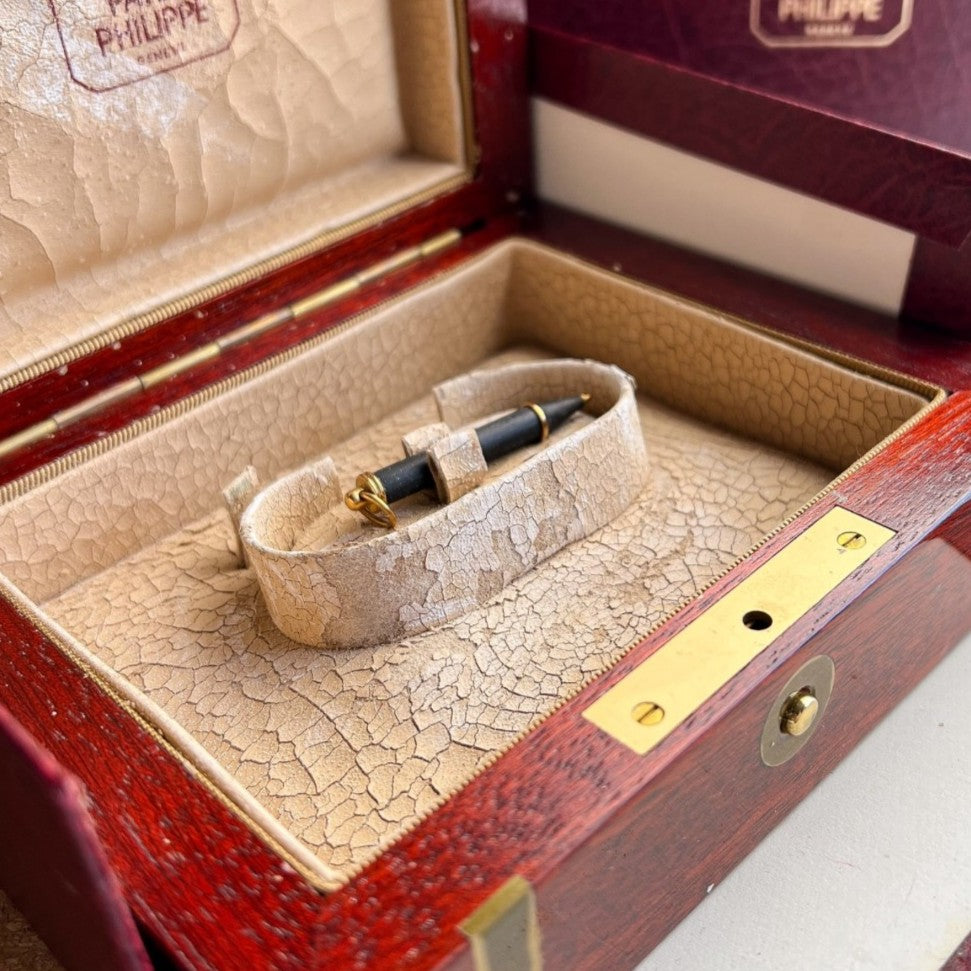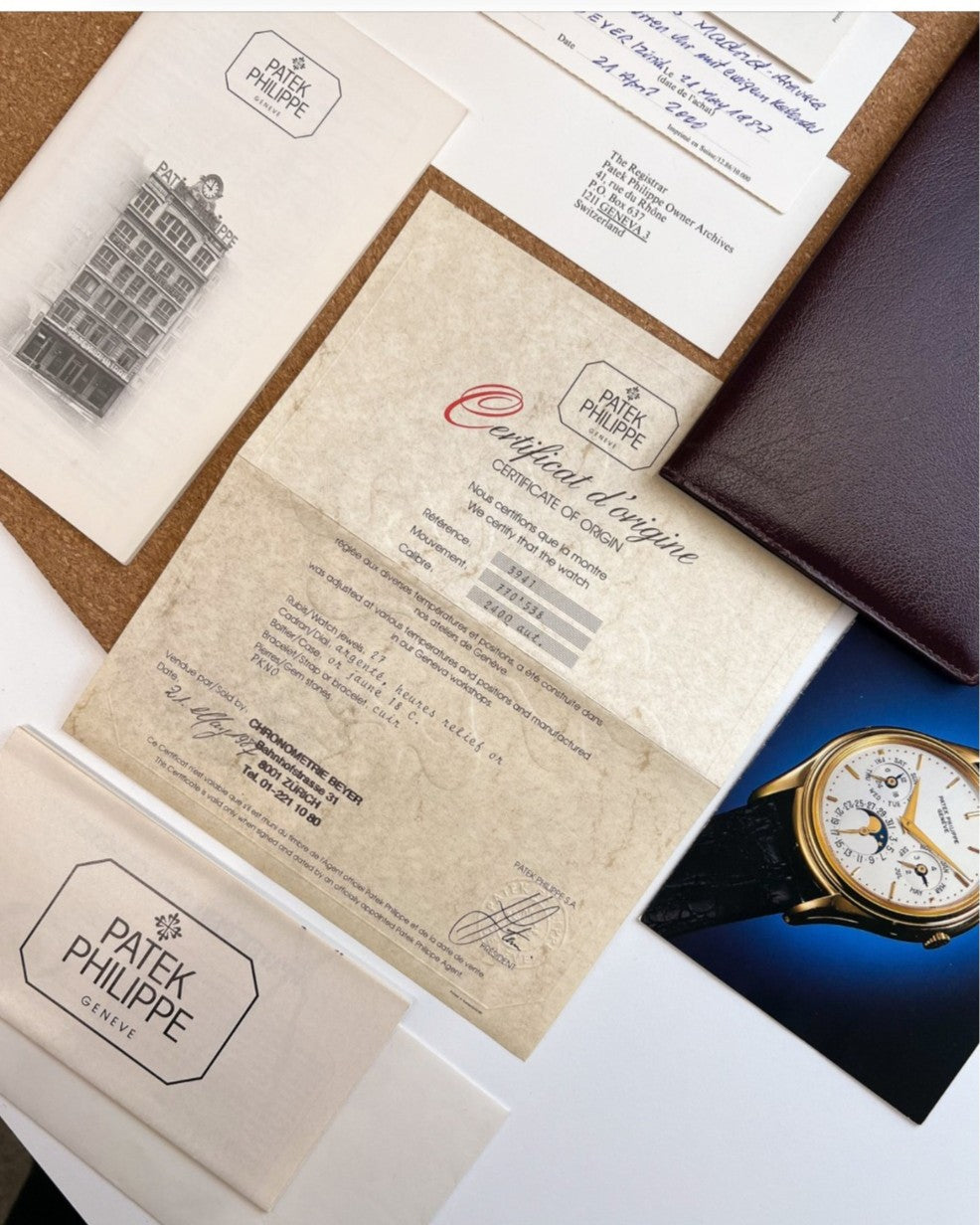




Patek Philippe 3941J - 1987 First Series - Perpetual Calendar
Patek Philippe Reference 3941J
First Series Dial with Sapphire Display Back
Movement No. 770’538 | Case No. 2‘823’680 | May 1987
A Rare Variant of the Legendary 3940, Captured in Transparent Elegance
TECHNICAL SUMMARY
All details are documented and disclosed to the best of our scholarly and technical ability.
I. IDENTIFICATION:
• Brand: Patek Philippe
• Reference Number: 3941J
• Case Number: 2‘823’680
• Movement Number: 770’538
• Unique Features: First Series Dial. One of Nine known to exist. Exhibition caseback variant of the Reference 3940. 41 known Reference 3941s are known to the marketplace.
II. MOVEMENT SPECIFICATIONS:
• Movement Type: Automatic with micro-rotor
• Caliber Number: 240Q aut.
• Movement Manufacturer: Manufactured in-house by Patek Philippe
• Complications: Perpetual calendar, moonphase, day, date, month, 24-hour indicator
• Jewels: 27
• Frequency (vph): 21,600
• Power Reserve: Approximately 48 hours
• Diameter: 27.5 mm
• Thickness: 3.75 mm (base caliber only)
• Water Resistance Per Manufacturer: Not water-resistant; untested
III. CASE SPECIFICATIONS:
• Case Manufacturer: Believed to be Atelier Réunis, Geneva (under contract to Patek Philippe)
• Case Diameter: 36 mm
• Case Material: 18k yellow gold
• Bezel Type / Material: Rounded polished bezel, 18k yellow gold
• Crystal Type: Sapphire (front and back)
• Lug Width: 19 mm
• Strap or Bracelet Material: Brown leather, aftermarket WBLDN
• Strap or Bracelet Color: Brown with white stitching
• Buckle Type and Material: Authentic Patek Philippe period-correct yellow gold pin-buckle; minor wear
IV. AESTHETIC CHARACTERISTICS:
• Dial Manufacturer: Stern Frères
• Dial Color: Ivory-toned
• Dial Material: Lacquered metal, matte opaline finish
• Indices: Applied gold baton
• Hand Style: Leaf and baton
• Caseback Style: Sapphire display back
• Engravings: None
V. DOCUMENTATION & ACCESSORIES:
• Original Box: Yes
• Original Papers: Yes – Certificat d’origine, instruction booklet, registry card, location brochure, promotional inserts, and Reference 3940 manual with Chronometrie Beyer sticker
• Extract from the Archives: No
• Other Included Accessories: Calendar pusher (origin unverified)
VI. SERVICE HISTORY:
• Last Serviced When: Unknown
• Serviced By Whom: Unknown
• Type of Service Performed: Unknown
VII. CONDITION & AUTHENTICITY:
• Condition Summary: WRISTORIAN Grade
• Authenticity: All visible components confirmed original or period-correct; strap is aftermarket due to CITES import regulations
• Maintenance, Service, or Restoration Disclosure: No confirmed interventions or replacements known at this time
VIII. PROVENANCE & PRODUCTION CONTEXT:
• Year of Production: 1987
• Production Period: Manufactured between 1986 and the late 1980s
• Provenance / Ownership History: Believed to have been retailed by Beyer Chronometrie (based on documentation)
WRISTORIAN’s Perspective:
There are timepieces that you acquire for their design. Others, for their engineering. And then there are those few pieces you acquire for what they reveal. This Reference 3941J falls quietly and precisely into the latter category.
To the casual observer, it resembles the famed Reference 3940: Patek Philippe’s most celebrated perpetual calendar of the modern era. But beneath that resemblance lies something more uncommon. This is the 3941J – a reference so sparingly produced that only 41 examples are recorded, and among those, only nine are believed to carry the First Series dial. It is, effectively, the earliest 3940 dial architecture, housed in a sapphire-backed case that permits the mechanical soul of the timepiece to be observed.
The story begins in 1985, at the Basel Fair. Patek Philippe unveiled Reference 3940 in an atmosphere still shadowed by the Quartz Crisis. Mechanical horology was not yet assured of its survival, and for many, the idea of a slim, complicated, manually-intensive timepiece appeared anachronistic. But Patek Philippe had a different conviction. The 3940 represented a declaration of faith in the relevance of traditional watchmaking — and, more than that, in its ability to move forward.
Reference 3940 was a clean break from the heavy, brash aesthetic of the 1970s. It measured 36 millimeters, was startlingly thin for a perpetual calendar, and relied on a newly introduced automatic caliber: the 240Q. The model would remain in production for two decades, concluding in 2007, and across that arc it would evolve through multiple dial series and case variants. Yet even within its first few years, a rare sibling emerged, and that was the Reference 3941.
First appearing in 1986 and quietly phased out by the early 1990s, the 3941 was a short-lived reference. It paralleled the 3940 in architecture and function but differed in one decisive aspect: it featured a sapphire caseback. In an era when most complicated Pateks featured solid casebacks, this was an exception. It allowed owners to view the micro-rotor movement within. The micro-rotor was a feature so desirable that, in time, it would become the norm. But at its debut, this kind of openness was almost subversive.
Inside the case beats the Caliber 240Q, a movement designed and manufactured entirely in-house by Patek Philippe. Introduced in 1977, the base Caliber 240 was a pioneering response to the Quartz Crisis: ultra-thin, automatic, and equipped with a micro-rotor to preserve elegance without compromise. The Q designation adds a full perpetual calendar module. This was a feat of vertical engineering introduced in 1985 with the debut of the 3940 family. Unlike the modular approaches of outsourced ébauches common in mid-century pieces, the 240Q was and remains a proprietary triumph. It is both technically accomplished and visually quiet. A movement that doesn’t need to announce itself, but rewards study.
But the movement alone does not make this timepiece rare. The case, most likely produced by Atelier Réunis under contract with Patek Philippe, reflects the Geneva hallmark of disciplined restraint. Atelier Réunis was among the most trusted case manufacturers of the 20th century, eventually integrated into Patek’s own operations. In 1987, however, the firm still operated semi-independently, executing each 18k yellow gold housing to Patek Philippe’s uncompromising tolerances. These were not generic gold shells; they were architectural instruments, shaped to cradle the caliber within while retaining visual lightness.
Then there is the dial and it is here the nuance becomes exciting. Manufactured by Stern Frères, this matte ivory-toned dial is not enamel but lacquered metal, executed in a finish that closely resembles enamel under the loupe. The typography is early: inward-printed minute track, no central crosshair, no outer seconds scale. Of particular note are the sharply sunken subdials, which exhibit clean vertical drops which is a visual distinction unique to the First Series. In subsequent iterations, these registers adopt more gently sloped sides, blending into the dial with less architectural contrast. Here, each complication is demarcated with clarity, lending the dial a quiet authority rooted in precision rather than flourish. It speaks not to mass production, but to the first design intent of the 3940 family. It is a dial made for those who look closely.
And what of the documents? This particular example retains its full suite of papers, including its Certificat d’origine, instruction booklet, registry card, and a set of promotional documents. Not the least interesting and important of the documents is the Reference 3940 manual bearing the sticker of Chronometrie Beyer, the famed Zurich retailer and longtime Patek Philippe partner. While the exact point of sale is unconfirmed, the presence of the Beyer-labeled literature is a telling clue. The fact that it has survived alongside the original box and calendar pusher (of unverified origin) adds a layer of confidence to the package. It suggests quiet stewardship of a timepiece preserved with integrity, not theatricality.
Even the strap tells part of the story. Due to CITES restrictions governing the international transport of exotic leathers, the original strap could not accompany the timepiece during its last export. In its place is a brown leather WBLDN strap with white stitching. The strap is tastefully chosen, attractive, understated, and appropriate. The buckle, by contrast, is original: a period-correct Patek Philippe yellow gold pin-buckle showing only minor evidence of wear.
Of course, none of these individual features — movement, case, dial, documents — would mean as much in isolation. Their significance emerges only in combination. This 3941J is not just well-preserved. It is one of the few known examples of a reference produced in extremely small numbers, from a transitional moment in Patek Philippe’s modern history, bearing the earliest dial configuration, with a crystal caseback that prefigured an entire design shift.
There is something quietly instructive about a timepiece that asks so little of its owner while offering so much to the historian. It is not an icon. It is not a trophy. It is a reference for the connoisseur who already knows.
This is a Reference 3940 First Series — with nothing concealed and nothing overstated.
Each WRISTORIAN timepiece is delivered with understated elegance, a rigorous scholarly dossier, and a clear account of its condition, originality, and any prior intervention, to the extent permitted by available evidence and expert review. with understated elegance, a rigorous scholarly dossier, and a clear account of its condition, originality, and any prior intervention, to the extent permitted by available evidence and expert review.*
Choose options





